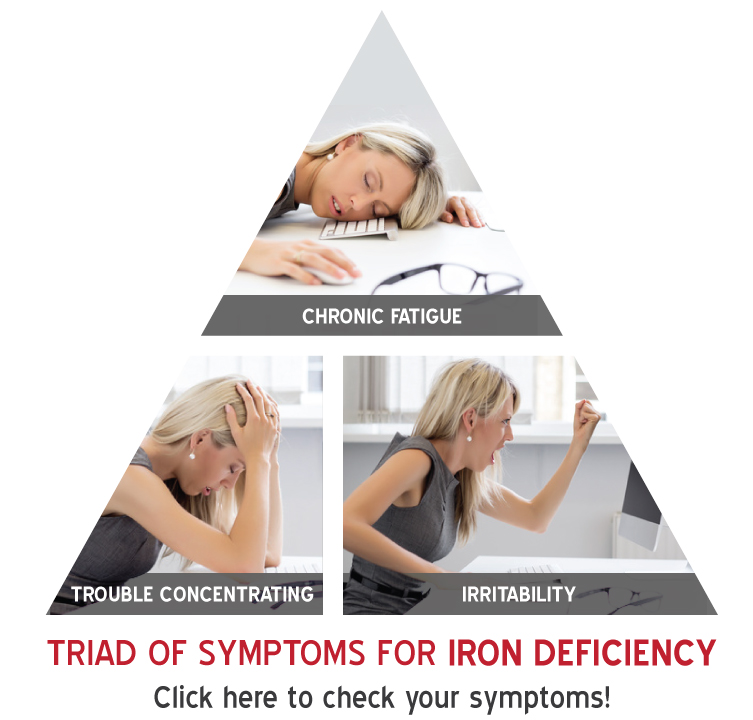Many of the symptoms related to iron deficiency can be attributed to other causes in today’s often busy lifestyle. However, when there is a collection of specific symptoms, it would be in your best interest to check with your physician and exclude iron deficiency as a cause.
When discussing a possible diagnosis of iron deficiency, I go through a checklist of symptoms (Symptoms Checker) which you can see below. But first, I look for what I consider to be the “triad of symptoms” (chronic fatigue, trouble concentrating, irritability); a patient presenting with any one of these three symptoms causes me to suspect iron deficiency.
Symptoms of Iron Deficiency
Triad of Symptoms:
- Chronic fatigue
- Trouble concentrating
- Irritability or mood swings
Learn more about the Triad of Symptoms →
Other Symptoms that Suggest Iron Deficiency:
- Insomnia (including restless leg syndrome)
- Generalized weakness
- Tiring quickly
- Pronounced lack of energy
- Trembling (including chills when others do not feel cold)
- Pale skin (gums and inner eyelids)
- Decreased appetite
- Headaches
- Breathlessness with minimal physical exertion (low exercise tolerance)
- Thin and fragile fingernails (may look pale and develop ridges or become concave/spoon shaped)
- Inflamed or smooth tongue, cheeks, lips and gums
- Hair loss or hair that is dull, brittle, or breaks easily
- Pica, a craving to eat “non-food” items (the most common craving is to chew ice but this can also include paper, dirt/soil, and other non-food items)
While children with iron deficiency can often experience the majority of the symptoms mentioned above, it is especially useful to look for the following signs in children: pale skin, fatigue or decrease in physical activity, poor food intake (picky eaters), poor concentration, mood swings, and poor growth/development.
If you (or your child) have some of the symptoms listed above, it is recommended to speak to your doctor regarding the possibility of being iron deficient.
Another checklist I run through is a risk assessment, to determine if the patient is at risk of developing iron deficiency.
Iron Deficiency At-Risk Groups
Adult At-Risk Groups:
- Women with heavy menstrual periods (also known as Menorrhagia)
- Pregnant women (especially during the first and second trimester)
- Vegans or vegetarians
- Individuals whose diet does not include a lot of red meat
- Patients with Chronic Kidney Disease
- Patients with gastrointestinal disorders (including Crohn’s Disease, Ulcerative Colitis, Irritable Bowel Syndrome with Hypermotility, or loss of the digestive tract related to surgical intervention)
- Patients with Celiac Disease
- Frequent blood donors
- Elderly people (due to malnutrition and malabsorption)
Learn more about Adult At-Risk Groups →
Child At-Risk Groups
- Babies (premature or low birth weight, prolonged breast feeding and/or introduced to whole milk prior to 1 year of age)
- Children who drink 600 mL of milk or more daily
- Children during periods of rapid growth (children aged 9 months – 3 years old and children going through puberty)
- Teenage girls experiencing menstrual periods
- Patients with Celiac Disease
Learn more about Child At-Risk Groups →
If you (or your child) identify with any of these risk groups and are experiencing some of the symptoms listed above, it is highly recommended to speak with your doctor regarding the possibility of being iron deficient. Even if you fall into one or more of the at-risk groups above but are not symptomatic (or vice versa), it is advisable to speak with your doctor – your doctor may choose to include screening tests for iron deficiency with your annual physical. If iron deficiency is discovered early enough, a change of diet and/or the use of an oral iron supplement may be all that is needed to help you feel better faster.
Content and advice provided on The Iron Maiden is for information purposes only and should not serve as a substitute for a licensed health care provider, who is knowledgeable about an individual’s unique health care needs



Why are people with Celiac more to being iron deficient? I have both problems and B12 deficiency also.
Hi Lynda – I am planning a future article on this topic, but for the time being, there are two factors that that can contribute to iron deficiency: The ability to digest iron, and the ability to absorb iron. Celiac disease limits the ability to absorb digested iron. This combined with your low B12 are likely suspects of your current diagnosis of anemia. You can take a look at my article for people at risk for some info on iron deficiency and celiac disease.
Leona
Hi, once you start taking iron how long will it take for you to notice a change in how you feel?
Hi Jo – Good question. Unfortunately, this is not so easy to answer as it depends on many variables, not the least of which is how low your serum iron and ferritin was when you started supplementing. Other factors include what you’re using to supplement and how much your unique gut is able to absorb.
Under optimal conditions, patients with a Ferritin Level over 20 using a non-salt iron supplement should start feeling better in 6-10 weeks, but everyone is different! Some patients will feel better within days, others need to get their iron level back to normal before feeling better.
Leona
I’ve had anxiety, some depression, hair loss the past several months. My dr tested me blood and my result was 28. She put me on Palafer 300mg (100mg elemental iron). How low does ferreting have to be for supplementation? Also, I would like to start with 50mg of elemental iron as I believe 100mg is too high. What is your professional opinion?
Thank you.
Hi Sam,
It’s difficult to comment because I am not sure what lab result of 28 you are referring to… Since your physician has suggested iron supplementation, I will assume it’s your Ferritin level. By my common lab, a normal Ferritin level is 20-300 mg. But, we know that patients can be symptomatic of iron deficiency at Ferritin levels of less than 50.
Please take a look at my article regarding a comparison of the different types and iron and iron supplements available on the market – it is estimated that non-heme iron has a 16.8% absorption rate which means that the Palafer brand that your physician has recommended (which has 100 mg of elemental iron) is really only providing you with 16.8 mg of absorbed elemental iron.
I understand your apprehension, but strongly recommend that you discuss your concerns with your primary health care provider who understands your lab results and your personal health history better.
Please let me know if I can help further.
Leona
A great write-up. Thank you so much!